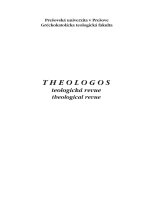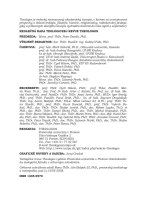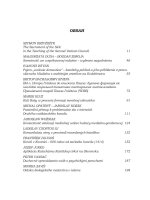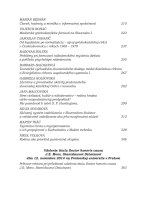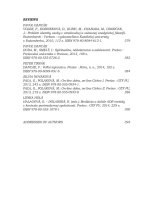From f peter gojdic to bishop paul spiri (1) 20
Bạn đang xem bản rút gọn của tài liệu. Xem và tải ngay bản đầy đủ của tài liệu tại đây (131.58 KB, 1 trang )
SZYMON DRZYŻDŻYK
which in its essence contained the idea of repeated
reception of the sacrament.
Each of the above-mentioned points in addition to the new wording,
had what was called emendationes – amendment to the proposals, which
amounted to five. One of them relating to number 59 suggested that the
priests themselves could bless the oil of anointing the sick if it turned out
that it had not been blessed by the bishop. Others suggested a return to
the original method of administering the sacrament as more appropriate.
Interestingly, there was also a proposal to number 57, to more specifically identify the person who can receive the anointing: „propter infirmitatem vel senium“ – due to illness or old age. The commission constituted
this amendment and placed it in the context of the number, the question
about the validity of this formulation referring to the Code of Cannon Law,
Cannon 940 § 1.25
The above points, together with emendationes had been worked on
by specialists of the Latin language and adopted at the plenary session
of the Liturgical Council held in September 1963 just before the start of
the second session of the Council, which took place on 29 September. As
a result of the work these points received new numbering – from 73 to
75 in the third chapter of the future schema of the Constitution on the
Sacred Liturgy.26
After many debates and re-examination in the subcommittees it
succeeded in gaining 2107 placet27 and in consequence acceptance into
chapter III on 21 November 1963. The entire document reforming the liturgy of the Roman Catholic Church was finally adopted under the name
Sacrosanctum Concilium on 4 December 1963.
The Constitution on the Sacred Liturgy of Vatican II was enacted
exactly on the 400th anniversary of the closing of the Council of Trent.
25
26
27
20
“Extrema unctio praeberi non potest nisi fideli, qui post adeptum usum rationis ob
infirmitatem vel senium in periculo mortis versetur“ – “Extreme unction is not to be
extended except to the faithful who, having obtained the use of reason, come into
danger of death from infirmity or old age.“ Codex Iuris Canonicis from 1917. In the
Polish Vademecum for Priests and Confessors a commentary on this canon can be
found: “In order to administer the sacrament validly or justly, the danger of death
must not be imminent nor grievous; it is sufficient and necessary, it would be morally
probable, and it is not objectively, but subjectively, that is, according to a rational
assessment of at least one man, for example, the pastor. Whenever the disease is
therefore dangerous and difficult, administering the sacrament validly and justly,
even to stipulate that the patient will continue to live months or even a whole year.“
K. KARŁOWSKI, Vademecum proboszcza i spowiednika. Praktyczny przewodnik
w zakresie przepisów prawa kościelnego, Poznań 1957, s. 178.
cf. J. STEFAŃSKI, Sakrament..., s. 39.
cf. J. STEFAŃSKI, Sakrament..., s. 40.
